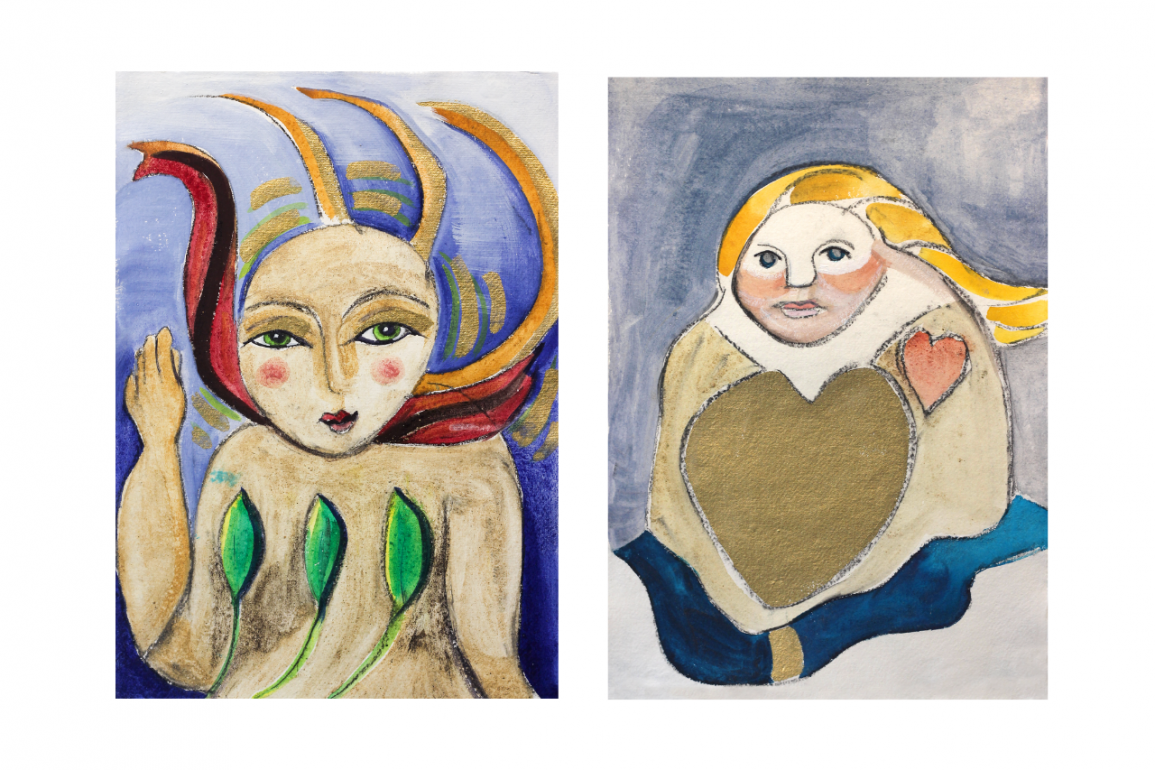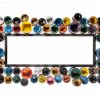Opening up Possibilities with Artist Sarah Dixon – Women Talking talks to artist facilitator and coach Sarah Dixon about her inspirational journey supporting individuals, communities, and institutions. Sarah’s art and coaching create a deeper connection with nature as well as with one another creating a more inclusive, healthier for us and generations to come.
Her unique approach is deeply relational, exploratory, and responsive. Working with Sarah gives you the opportunity to do profound and meaningful work on the themes and patterns that affect us all, in a curious, playful, and creative way.
When did you first discover your artistic talents?
“One of the earliest photos of me is about age 2, painting at nursery with a very concentrated look upon my face. I loved making drawings and making things as a child, although I also wanted to be a biologist (naturalist). I don’t think I was particularly talented, but the health benefits of creativity have always been important to me. I think as a teenager at boarding school there were some key moments – being in the art room and making a series of paintings of faces, very intuitively and fast. Seeing a slide of Rousseau’s “The Gypsy” – painting had a huge impact on me emotionally and I wanted to go to art school. However, I was good at science and was firmly steered towards that. I studied Biology and I did love it – especially the part where we had to draw zoological specimens or take up botanical drawing! My work in rainforests and other high biodiversity environments – and with the people that live there – continues to inspire me and feed my art”.
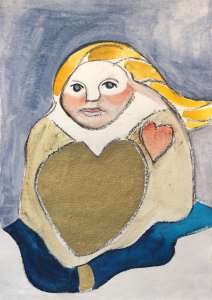
What drew you to the idea of Goddess Paintings?
“After studying and being inspired by icon painting some years ago, I began looking for an iconography that I could relate to more, that reflects my own beliefs and feelings about the world and offers me inspiration and guidance. The Goddesses emerged during an artist residency at Hawkwood (supported by Hawkwood College and The Francis W Reckitt Arts Trust) in January 2022. I was using my time at this beautiful Gloucestershire venue to connect with the natural spring, the earth and living beings there. The paintings grew as I practised ritual and using egg tempera paint. I had been thinking about the possibility for a long time but in that time, it became really clear, and the Goddesses started to appear. I had just started studying Priestessing with the new Stroud Goddess Temple, of which I am a founding Director, and I began by creating a painting of Cuda, Goddess of the Cotswolds.”
What is the most popular Goddess Image and Why?
“That’s an interesting one – there are a few that several people wanted. One that surprised me was Elen of the Ways. She is not a well-known Goddess figure but is part of the Stroud Goddess Wheel. She is a goddess of the deer and the trackways, paths in the tangled wood. I think about 5 people now have her with them in their homes. Another popular one is Mother Moon – a figure of a mothering-moon, holding snug a tiny baby. I have sold several variations of her image. Although she is not a “known” Goddess she shows up in many forms across the world”.
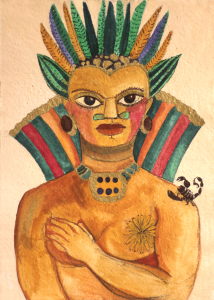 What is your favourite image?
What is your favourite image?
“Among my favourites are Sheela-Na-Gig and Xochiquetzal. Both are cultures I feel a connection with, and I am convinced Frida Kahlo drew upon the inspiration of Xochiquetzal who was the Mexica Goddess of Beauty, Pleasure, and Art. My mother is Irish, and I like Sheela-Na-Gig for her bawdy humour, her power, the connection to my own ancestry, and the mystery that surrounds her images that appear around Europe. I’m also happy with the energy and expression in those.
My favourite in terms of painting quality has to be the Sabrina-Moon painting. She has a refinement and flow, a warmth, lots of detail – I would like to make more like that one!”
What paint do you use for your paintings?
“ I make my own paint using egg yolk and pigments. This is the ancient technique I learnt from icon painting; it was also used throughout art history by artists such as Botticelli. It’s so easy to make and yet can last for centuries. It’s very practical as well as beautiful. Since I had a child, I found this much more accessible than using the slow, complex, and messy oils that I used to work in. The pigments come from art shops, but I also make my own from clay, chalk, red brick, and charcoal – anything I find really. I like to use materials I find in the environment to bring earthy energy into the work. I also use spring water from Hawkwood and other local places as the mixing fluid. I see this as a more ritualistic and energetic aspect of the work, and it is important to the project to do this”.
Has it been difficult to source recycled paper for your projects?
“I have found several suppliers via Etsy and eBay, however, they come in small batches, so it is hard to get the exact same ones repeatedly. The papers vary in thickness, smoothness, colour and sometimes also in size. They are beautiful handmade papers, and they have a lovely texture as well as the natural variation across them”.
When did you decide to include the Kids Art Club in your offering? What was the inspiration behind the idea?
“I see art as an innate human behaviour, with ancient roots and we see this most clearly in young children who tend to feel free to express and explore with mark making and handiwork. I don’t want to generalise too much – some people just aren’t really into art! but I love to see the freedom of expression in children. As the school curriculums have cut back on arts, many teachers are working hard to keep creativity in the schoolroom, but I saw an opportunity for me to offer something a bit different. I always like to include nature-inspiration so I try to find venues where we can go outside and look at trees and plants and bugs. I offer a space for fairly free expression – simple materials and lots of opportunities to develop their ideas. The children energise and inspire me and it’s like a nourishing cycle for my own art to hold space for them”.
What is the WAAS and how are you involved?
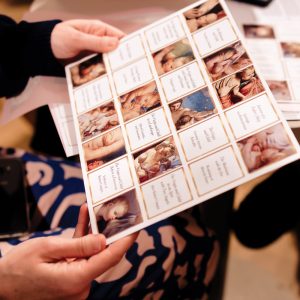

“The WAAS is The Women’s Art Activation System. I came up with the idea for this when my daughter was a baby and through conversations with other artists I met, it started to become a reality. It is now me and co-founder Sharon Bennett. We run creative workshops for people who recently gave birth, alongside caregivers such as midwives and mental health professionals in a project called “The Baby Makers”. We are also working with our local Museum to explore the histories of birth and caregiving in the Stroud District. We made a game with stickers for National Gallery visitors, called “The Milky Way”, in which you can hunt for breastfeeding in paintings and stick the pictures on a board. This is very different from the painting practice – it is much more socially focused – but for me, it is all about honouring the notion of “the divine feminine” and empowering those with a female experience. I am also conscious of gender binaries and how harmful they can be, so part of what I want to try to achieve is a sense of the diversity of what “feminine” means and perhaps it is in a way more about just stepping out of the dominant pressures and into a more open, creative, connected, and caring way of being for all life. Sharing that amazing energy of evolution and biology, the joy of living and the creativity of the forces that renew and generate life”.
Lilly Light

